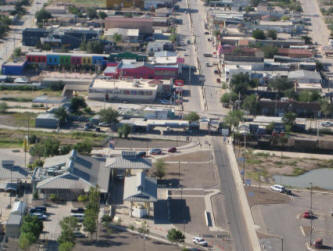|
|
|
Just after 5 p.m., following a daylong drive from Odessa, Tex., during which the front wheels of the Volvo made a worrisome sound like a helicopter’s whump-whump-whump, I arrived at Martha’s Place (204 West Lima Avenue, 575-531-2467; Los Milagros Hotel ). It is a wide adobe-style building, with balconies and a homey interior that lived up to the Web reviews. Martha Skinner, a real estate agent and the town’s former mayor, showed me to a pale-blue bedroom and gave me my first tutorial in Columbus life: If I wanted to eat, she said, I’d need to do it soon — all the restaurants close at six o’clock. Fifteen minutes later, I was tucking into a “wet” burrito ($7), full of luscious shredded beef and smothered in red chili sauce, from the Pancho Villa Cafe (327 Lima Avenue, 575-531-0555). The restaurant’s name, it turns out, comes from the town’s history.
The
next morning, I visited the Columbus
Historical Society Museum
(575-531-2620), in an old train
station full of archival
photographs, old newspapers and
other artifacts. There I met W. Lee
Robinson Jr., a talkative, balding
man who said everyone calls him
Radar because he looks like Radar
from “M*A*S*H.” Back in early 1916,
Radar explained, Mexico was in
upheaval, and Pancho Villa, a
revolutionary general, was feuding
with the federal government in
Mexico City. This conflict might
have stayed within Mexico’s borders,
except that Woodrow Wilson decided
to end his support of Villa and back
Mexico City instead. In revenge for
this slight, Villa sent his forces
across the border on March 9, 1916,
to raid Columbus. They burned
buildings, looted businesses and
killed 10 citizens and 8 soldiers
before being routed.
The attack left Columbus with an
acute sense of the border, its
identity forever intertwined with
Palomas’s. For decades, residents
have been freely crossing into
Mexico for taco dinners, duty-free
cigarettes and liquor, and even
visits to the dentist. But they’ve
also become hyper-aware of their
counterparts — the Mexican
immigrants, illegal or legal, who
cross over into America, some
carrying drugs, others dreams. And
whatever their feelings about the
border, they seem to understand that
Columbus would not exist, either in
history or today, without
Palomas —
and vice versa. That strange
symbiosis has gotten stranger in
recent years, with post-9/11
security measures and
anti-immigration policies making the
journey from south to north tougher.
And it may get harder still. One
evening, I drove out to look at what
is known simply here as “the fence,”
the controversial barrier being
built between the two countries. My
guide was Radar from the historical
society, who also happens to be a
radio operator for the Minutemen
Project (www.minutemanproject.com),
a border-watch group seeking to
stanch the flow of illegal
crossings. As a light rain fell,
Radar explained that his group had
developed a harmonious relationship
with the United States Border Patrol
— the Minutemen spot Mexicans
crossing illegally, then pass the
location to law enforcement. I was
skeptical, but when we neared the
fence, he chatted amicably with
several Border Patrol officers and
they let us through without a
problem. The fence, it turned out,
is far from finished. There was a
concrete foundation that went down
six feet (too deep to tunnel under),
steel pylons that soared 15 feet
(too high to jump from), and
X-shaped beams constructed from
railroad ties (too tough to drive
over).
|
|
One day, just before lunch, I set off for Mexico. The well-paved road to the border was barren most of the way, but ended in a shopping center that included a Western Union, a Family Dollar supermarket and a duty-free liquor store. The Mexican border guards waved me through, and I was in Palomas. Compared with Columbus, the roads were rougher, the buildings denser and the people poorer. The Pink Store (Zaragoza 113; 505-531-7243), however, shone like a beacon of affluence. It is the town’s prime tourist attraction, a kitschy restaurant and handicrafts shop, and amid tin crucifixes, vividly painted mirrors, carved wood animals and several other gringos. I ate and drank a margarita. Lunch cost $7.15 with tax, but I left craving more. Luckily, this was Mexico, and down the side streets were taco and torta stands. |
A pair
of tacos de barbacoa
cost $1.25. The sun was hot and high
in the sky, but I walked around
Palomas anyway, curious about who
I’d meet. At a brand-new hotel, the
owner asked me to say hello to
Martha Skinner; he is her dentist.
At a shaded park, another man told
me he was on his way to Phoenix,
Ariz., to do roofing work in the
120-degree heat. I kept returning to
Palomas over the next couple of
days, not only to fill my belly with
inexpensive food (Gámez, on Cinco de
Mayo Street, had excellent grilled
chicken) and my car with inexpensive
gasoline ($31.25 for a full tank at
Pemex, about $8 less than in
Columbus). Once, I stopped in at a
La Reina de Michoacán ice-cream
parlor where I had a fantastic guava
paleta ($1) and met an older man
carrying a fat pet lizard. While he
let it run around his table, he told
me in awkward English that he used
to work illegally in San Diego
before being deported. Now he was
holed up in Palomas, biding his time
till he could cross the border
again. As he pronounced his name —
Charles, not Carlos — I could sense
his pride in simply having lived on
the other side.
When I drove back to New Mexico that
night, the United States border
guards pulled me over for
questioning — apparently, they don’t
see many New York license plates and
even fewer visa-filled passports.
They were friendly, but still, my
heart beat faster, and I tried to
imagine how a foreigner must feel. A
single wrong word, a misunderstood
cue or bureaucratic slip-up might be
enough to strand you in Mexico,
three miles from the sleepy town
that might be your gateway to a new
life. After several minutes, the
guards handed me my passport and
sent me on my way. The Volvo wheezed
into gear, and I returned to my
pale-blue bedroom in someone else’s
house.
Click
to visit our page sponsor:
|
Get on
your horse and ride to the
Hole in the Wall Getaway Your Old West Hideout Experience! (Adults only pardners!) |




